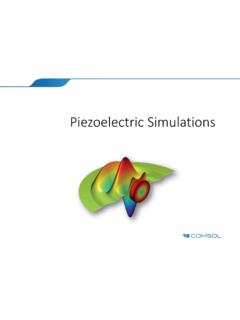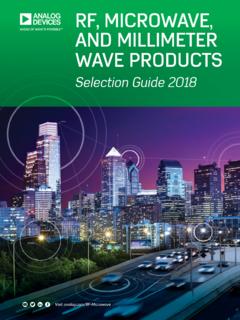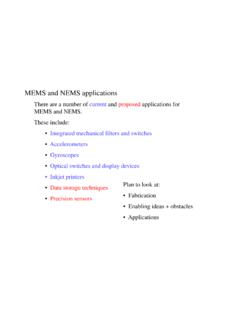Transcription of format adjusted Design of equalized ROADMs devices ... - UPM
1 Design of equalized ROADMs devices with Flexible Bandwidth Based on LCoS Technology M nica Carrero Mora, Alfredo Martin Minguez , Paloma R. Horche, Abstract This paper describes the theory, Design , applications and performance of a new Reconfigurable Add-drop Multiplexer (ROADM) with flexible bandwidth allocation. The device can address several wavelengths at the input to four output fibers, according to the holograms stored in a SLM (Spatial Light Modulator), where all the outputs are equalized in power.
2 All combinations of the input wavelengths are possible at the different output fibers. Each fiber has assigned all the signals with the same bandwidth; the possible bandwidths are , 25 GHz, 50 GHz and 100 GHz, according to ITU-T Recommendation. It is possible to route several signals with different bandwidth in real time thanks to Liquid Crystal over Silicon (LCoS) technology. Keywords ROADM; LCoS technology; Flexible bandwidth selection; Mixed holograms; Cascaded ROADM effect. I. INTRODUCTION The increment of high speed services requires DWDM optical transport networks in order to transport them.
3 Currently, these networks are able to carry 10/40/1 OOGbps channels and in a near future, 400 Gbps and lTbps channels. The evolution towards 400 Gbps/lTbps channels produces the increment of the bandwidth per channel. To ensure the coexistence of channels with different speed and bandwidth, ROADM devices are the key components. Different technologies have been proposed for the implementation of ROADMs , like MEMS or LC; each one has its own advantages and drawbacks, but neither is able to route channels with flexible bandwidth, only they can route with a fixed grid due to the size of the pixel.
4 The main characteristic of holographic ROADMs is the easy way of changing the tuning and power level of the signal ate the output fiber by the implementation of different holograms in real time. In section 2 of this paper the operation principle of the device is described, based on the diffraction produced when the light passes through a fixed grating and SLM where phase holograms are stored. Section 3 is dealing with the Design of the holographic device, taking into account the focal distance for the lens, spatial period for the fixed grating, position of output fibers, and the number of pixels in the SLM.
5 Section 4 shows the transfer function of the ROADM and the operational limitations. Section 5 studies the possibilities of mixed holograms for different wavelengths. In Section 6 it is developed an equalized solution with SOA. And, finally, Section 7 gives an explanation about the effects of cascaded ROADMs transfer function in optical networks. II. BASIC OPERATION PRINCIPLE The working principle of our device is based on the angular dispersion (diffraction) of the incident wavelength when a polychromatic light reaches a diffraction grating.
6 Considering the incident light perpendicular to the grating, the relationship between the diffraction angle, p\ and the wavelength, X, is given by sin(3 = m*A (1) where m is the diffraction order and d the grating spatial period. For dynamic hologram applications, m = +1 is usually considered because it is the first diffraction order with the maximum intensity; in (1) d > X has to be reached. According to (1), if there is a change in the spatial period d or in the incident light wavelength, X, the diffraction angle, P will also change.)
7 Consequently, we can implement an optical router by using this phenomenon. A. Implementation with a SLM Most of the diffraction gratings have a fixed period, which prevents the implementation of tunable devices . A way to allow these variations is to use a Spatial Light Modulator (SLM) to implement Computer Generated Holograms (CGH). The pixelated structure of the SLM produces the effect of a two-dimensional diffraction grating when the device is illuminated with coherent light.
8 In the SLM every Liquid Cristal over Silicon (LCoS) micropixel can be electro-optically configured to provide a phase modulation for the incident light. diffraction grating Fourier plane m = 0 Fig. 1 Diffraction grating effect Therefore, by managing the hologram on the SLM and its spatial period, we obtain a programmable diffraction grating [1]. The micropixel size is supposed to be thousands times lower than the typical pixel size (10 um), about 10 nm. In order to obtain enough resolution it is necessary to use a fixed diffraction grating, with a high spatial frequency (low spatial period), together with the SLM giving a high resolution filter .
9 The two parameters that impact strongly on the size of the optical device are the focal distance of the lens,/, and the product ND, where D is the size or the micropixel and N is the number of micropixels in one dimension of the SLM. The relationship between the hologram spatial period and A is: H ^0<n<^ n 2 (2) where n is an integer number which depends on the type of hologram (pattern), typically black/white bars for this application. Ill. Design OF A FLEXIBLE BANDWIDTH HOLOGRAPHIC DEVICE A.
10 ROADM structure In order to Design a holographic optical device, a "4f-folded" structure is chosen using transmissive SLM and transmissive fixed grating. We have chosen this type of structure due to the reduced size of the device in comparison with other possible structures, like "lineal 4f', where the dimension in the optical axis is four times the local distance of the lens used. Fig. 2 illustrates the holographic structure selected for the present device. The holograms (black and white bars) are uploaded via a PC-based interface.












